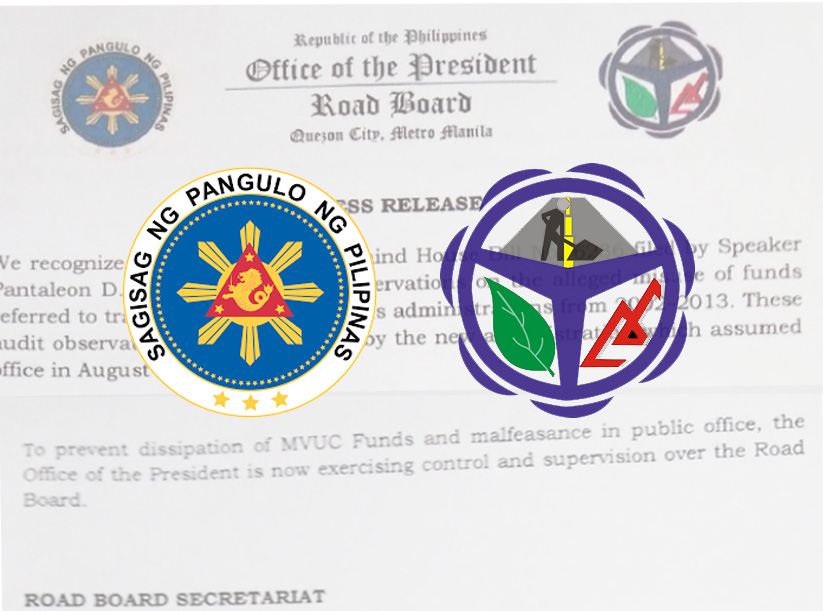In early 2018, the planned abolition of the Road Board was high on the legislative agenda, and the only issue it seemed was when it would happen.
“It is high time to abolish the Road Board,” said Sen. Emmanuel “Manny” Pacquiao in his Jan. 16 sponsorship speech recommending for approval the senate bill seeking to dissolve the board, which manages billions in motor vehicle user’s charge (MVUC) funds.
Allegations of corruption have continually hounded the MVUC funds, an amount collected from owners of motor vehicles, and the government’s third largest income source.
As the year comes to a close, the abolition of the Road Board has not only failed to materialize. It has also become the subject of an impasse between the Senate and the House of Representatives, which on Sept. 12 approved and cancelled respectively their bills to abolish. (See Road Board abolition in limbo; may affect road safety funding)
Palace spokesperson Salvador Panelo on Dec. 18 said President Rodrigo Duterte will sign into law the bill abolishing the Road Board “as soon” as it is submitted to him; Majority Leader Rolando Andaya Jr. the same day maintained the House had already withdrawn its approval of the bill.
Among the consequences of the impasse, which could carry over into 2019, was the Department of Budget and Management’s blocking out of MVUC fund releases until the issue has been resolved.
The uncertainty worries road safety advocates.
For Shiela Napalang, chair of the National Center for Transportation Studies (NCTS) at the University of the Philippines, the almost-passage of the Road Board abolition bill in September was a “really near miss.”
The House and Senate versions of the Road Board abolition bill seek to transfer its functions to the public works, transport and environment departments.
The House version raises the road safety funds allotment to 10 percent from the current 7.5 percent; the Senate version lowers it to 5 percent, giving local governments instead 50 percent of the funds for “road maintenance, traffic management, and road safety devices.”
“The road safety fund is the second highly utilized,” said Napalang in a forum hosted by VERA Files and the World Health Organization in early December, referring to the current 7.5 percent allocation for road safety programs from MVUC funds.
“Importante ‘yon (That’s important) because… everything has to be financed,” Napalang said. “We have to make sure that we have something to draw on while we talk about interventions.”
The Metropolitan Manila Development Authority (MMDA) during the same forum also expressed another funding concern.

Jacque Manabat, ABS-CBN Senior Multimedia reporter listens to Asec. Celine Pialago, MMDA spokesperson
Due to agency budget constraints, MMDA traffic enforcers are only deployed until 10 p.m., after which only night-shift mobile patrols are left to monitor the roads, said spokesperson Celine Pialago.
“Sa usapin po ng drunk driving (When we talk about drunk driving), people go to party, it will finish around three in the morning. We no longer have our deployment during that time,” Pialago said.
“We request po for additional budget para at least makapagstay po nang mas matagal yung mga enforcers natin on the ground (so at least our enforcers can stay longer on the ground),” she added.
Lawyer Evita Ricafort sees another concern on top of funding woes: implementation challenges hounding already existing road safety measures and pieces of legislation.
“You may have your laws, you may have your regulator trying to implement, but kung kulang naman tayo (but if we lack) for drink driving, kulang naman ang (if there’s a lack in) breathalyzers, then it’s not going to get anywhere even if you apprehend,” said Ricafort, a legal fellow of the Bloomberg Initiative for Global Road Safety.
On the Road Speed Limiter Act, which remains unimplemented despite having lapsed into law two years ago, Ricafort said: “If you don’t have the speed guns and if we don’t have the speed cameras, even if you have the speed limits and you have classified all your roads to have appropriate speed limits, it’s not going to get anywhere as well.”
About 7,000 Filipinos die annually from traffic-related deaths, based on WHO estimates. In 2015, the Philippine Statistics Authority recorded the figure at 10,012.
Sen. Joseph Victor “JV” Ejercito, who also spoke at the forum, suggested mandatory training for motorcycle riders to curb road traffic mortality figures; he said half of road casualties are motorcycle riders.
Solutions to work have to be based on data, said Napalang. Yet, data are limited and do not give a sense of the road safety landscape in the entire country, she said.
For example, most of the road crashes that get recorded are those that have happened only in Metro Manila, she explained.
A comprehensive data and analysis system would greatly help government agencies and advocates working to promote safer roads in the country, Napalang said, and borrowing a quote from economist Peter Drucker, added: “What gets measured gets managed.”
This story is produced under the Bloomberg Initiative Global Road Safety Media Fellowship implemented by the World Health Organization, Department of Transportation and VERA Files.



